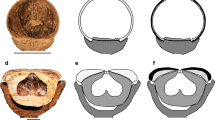Summary
Parthenocarpy, the production of fruits without viable seeds, is a widespread phenomenon in plants. While failure to effect pollination or fertilization is often cited as the cause of parthenocarpy, this explanation alone is inadequate to explain why plants produce, maintain and further develop fruits. Wild parsnips (Pastinaca sativa) frequently produce parthenocarpic fruit. When parsnip webworms (Depressaria pastinacella), specialist feeders on wild parsnip, were given choices between normal fruit and parthenocarpic fruit, they exhibited a strong preference for parthenocarpic fruit. However, on parthenocarpic fruit, insects fed less efficiently and grew more slowly than insects fed normal fruit. Parthenocarpic fruits, then, may act as decoys that divert herbivores away from fruits that contain plant offspring.
Similar content being viewed by others
References
Allen, S. E. (ed) (1974)Chemical Analysis of Ecological Materials. John Wiley and Sons, New York, USA.
Berenbaum, M. R. (1981) Patterns of furanocoumarin production and insect herbivory in a population of wild parsnip (Pastinaca sativa L.).Oecologia 49, 236–44.
Berenbaum, M. R., Zangerl, A. R. and Lee, K. (1989) Chemical barriers to adaptation by a specialist herbivore.Oecologia 80, 501–6.
Berenbaum, M. R., Zangerl, A. R. and Nitao, J. K. (1984) Variation in seed furanocoumarin content within wild parsnip (Pastinaca sativa).Phytochemistry 23, 1809–10.
Berenbaum, M. R., Zangerl, A. R. and Nitao, J. K. (1986) Constraints on chemical coevolution: wild parsnips and the parsnip webworm.Evolution 40, 1215–28.
Brittain, W. H. and Gooderham, C. B. (1916) An insect enemy of the parsnip.Can. Entom. 2, 37–41.
Darwin, C. (1876)The Variation of Animals and Plants Under Domestication. 2nd Ed. D. Appleton and Co, New York, USA.
Fagri, K. and L. Van Der Pijl. (1979)The Principles of Pollination Ecology. Pergamon Press, Oxford, UK.
Feinsinger, P. (1978) Ecological interactions between plants and hummingbirds in a successional tropical community.Ecol. Monogr. 48, 269–87.
Harper, J. L. and White, J. (1974) The demography of plants.Ann. Rev. Ecol. Syst. 5, 419–63.
Hawthorn, L. R., Bohart, G. E. and Toole, E. H. (1956) Carrot seed yield and germination as affected by different levels of insect pollination.Proc. Amer. Soc. Ag. Sci. 67, 384–9.
Hendrix, S. D. (1979) Compensatory reproduction in a biennial herb following insect defoliation.Oecologia.42, 107–118.
Hodges, R. W. (1974)The Moths of America North of Mexico: Gelechioidea Oecophoridea. Classey Ltd. and R.B.D. Publications Inc., London, UK.
Jermy, T. (1984) Evolution of insect/plant relationships.Amer. Natur. 124, 609–30.
Ladygina, E. Y., Makarova, V. A. and Ignat'eva, N. S. (1970) Morphological and anatomical description ofPastinaca sativa fruit and localization of furanocoumarins in them.Farmatsyia (Moscow)19, 39–46.
Murray, R. D. H., Mendez, J. and Brown, S. A. (1982)The Natural Coumarins. John Wiley and Sons, Chichester, UK.
Nitao, J. K. and Zangerl, A. R. (1987) Floral development and chemical defense allocation in wild parsnip.Ecology 68, 521–9.
Price, P. W., Bouton, C. E., Gross, P., McPheron, B. A., Thompson, J. N. and Weis, A. E. (1980) Interactions among three trophic levels: influence of plants on interactions between insect herbivores and natural enemies.Ann. Rev. Ecol. Syst. 11, 41–65.
Riley, C. V. (1888) The parsnip webworm.Insect Life 1, 94–8.
Stephenson, A. G. (1981) Flower and fruit abortion: proximate causes and ultimate functions.Ann. Rev. Ecol. Syst. 12, 253–79.
Stephenson, A. G. and Bertin, R. I. (1983) Male competition, female choice, and sexual selection in plants. InPollination Biology (L. Real, ed.) pp. 110–49. Academic Press, New York, USA.
Sturtevant, E. L. (1890) Seedless fruits.Mem. Torr. Bot. Club 1, 141–85.
Thompson, J. N. (1977) Plant plasticity, phenology, and herbivore dispersion: wild parsnip and the parsnip webworm.Ecology 58, 1112–19.
Willson, M. F. and Burley, N. (1983)Mate Choice in Plants. Princeton University Press, Princeton, USA.
Zangerl, A. R. and Berenbaum, M.R. (1990) Furanocoumarin induction in wild parsnip: Genetic and populational variation.Ecology (in press).
Author information
Authors and Affiliations
Rights and permissions
About this article
Cite this article
Zangerl, A.R., Berenbaum, M.R. & Nitao, J.K. Parthenocarpic fruits in wild parsnip: Decoy defence against a specialist herbivore. Evol Ecol 5, 136–145 (1991). https://doi.org/10.1007/BF02270830
Issue Date:
DOI: https://doi.org/10.1007/BF02270830




